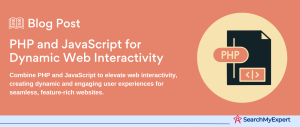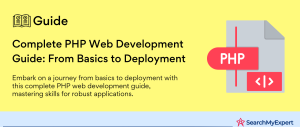PHP: Understanding the Power of Server-Side Scripting
What is PHP?
PHP, standing for Hypertext Preprocessor, is a cornerstone in the world of web development. Originally created in 1994 by Rasmus Lerdorf, PHP has evolved into a robust, open-source server-side scripting language that is essential for anyone looking to dive into dynamic website creation. Unlike client-side languages like HTML and JavaScript, PHP code is executed on the server, generating HTML which is then sent to the client. This unique feature allows PHP to deliver interactive, dynamic content to users, making it an invaluable tool for web developers.
PHP’s compatibility with various database management systems, and its ability to handle complex tasks like sending emails, managing user sessions, and manipulating files on the server, make it a versatile choice for a wide range of web applications. From simple websites to complex web applications, PHP’s extensive range of functionalities caters to both beginners and seasoned developers alike.
Why Learn PHP?
In the ever-evolving world of web development, learning PHP offers several compelling advantages:
- Creating Dynamic Websites:
PHP is instrumental in building dynamic and interactive websites. It enables developers to create pages that change in response to user inputs, time, or other variables, thereby enhancing user engagement. - Database Interaction:
PHP’s ability to interact seamlessly with databases like MySQL, PostgreSQL, and Oracle makes it ideal for developing data-driven websites. This interaction capability is crucial for applications like e-commerce sites, content management systems, and forums, where storing, retrieving, and manipulating data is a daily necessity. - Server-Side Functionality:
PHP runs on the server, providing a secure environment for processing user input, accessing databases, and managing sessions. This server-side functionality ensures that sensitive code and data are not exposed to the client, enhancing the security and integrity of web applications.
Basic Setup and Environment Requirements
To begin working with PHP, a basic setup is required, which includes:
- Web Server:
A server like Apache or Nginx is needed to handle requests and deliver content to users. For beginners, integrated solutions like XAMPP or WAMP can be used, which bundle a server, PHP, and a database system. - PHP Installation:
PHP needs to be installed on your server. Most web hosting services come with PHP pre-installed. For local development, PHP can be installed as part of the XAMPP or WAMP package. - Text Editor: Coding in PHP requires a text editor. Options range from simple editors like Notepad++ to more sophisticated Integrated Development Environments (IDEs) like PhpStorm or Visual Studio Code, which offer advanced features like syntax highlighting, code completion, and debugging tools.
- Database Management System (Optional): For projects involving data storage and manipulation, installing a database management system like MySQL is essential.
Understanding PHP File Structure and Syntax: The Foundation of Coding in PHP
Delving into PHP begins with understanding its basic file structure and syntax. This knowledge forms the foundation of coding in PHP, enabling you to write scripts that are both functional and efficient.
Basic Structure of a PHP File
- PHP Tags:
Every PHP script starts with the <?php tag and ends with the ?> tag. These tags tell the server where the PHP code begins and ends. oes here - It’s important to note that the closing ?> tag is optional if the file contains only PHP code.
- HTML Integration: PHP can be embedded within HTML. This integration allows you to create dynamic content within a web page. The PHP code is processed on the server, and the resulting HTML is sent to the client.
Variables and Data Types
PHP supports various data types, and understanding these is crucial for effective programming:
- Integers:
These are non-decimal numbers, either positive or negative. For example, $age = 30;. - Strings: A sequence of characters used for text. Strings are enclosed in quotes, e.g., $name = “John Doe”;.
- Booleans: This type represents two possible values: true or false. They are often used in conditional testing.
- Arrays:
A collection of values. Arrays in PHP can be indexed or associative, allowing for a wide range of data manipulation. - Others:
PHP also supports other data types like floats (decimal numbers), objects, NULL, and resources.
Operators and Expressions
PHP uses operators to perform operations on variables and values:
- Arithmetic Operators:
Used for basic mathematical operations. For example, + for addition, – for subtraction, * for multiplication, / for division, and % for modulus. - Comparison Operators: These include == (equal), != (not equal), > (greater than), < (less than), >= (greater than or equal to), and <= (less than or equal to).
- Logical Operators:
Used to combine conditional statements. These include && (and), || (or), and ! (not).
Control Flow and Conditional Statements in PHP: Directing the Flow of Your Code
In PHP, control flow and conditional statements are pivotal in directing the execution of code based on specific conditions. They allow for decision-making processes and repetitive execution of code blocks, enhancing the dynamic nature of web applications.
If/Else Statements for Conditional Execution
- Basic If/Else:
The if statement executes a block of code if a specified condition is true. The else clause executes an alternative block if the condition is false. - Elseif: When there are multiple conditions, elseif can be used to specify a new condition to test, if the first condition is false.
Switch/Case Statements for Multiple Conditions
Switch statements are a more streamlined method for evaluating multiple conditions:
The switch expression is evaluated once, and its value is compared with the values of each case. The break statement prevents the code from running into the next case automatically.
While, Do/While, and For Loops for Repetition
- While Loop: Executes a block of code as long as the specified condition is true.
- Do/While Loop: Similar to the while loop, the block of code is executed at least once before the condition is tested.
Functions and User Input in PHP: Enhancing Interactivity and Code Efficiency
In PHP, functions and handling user input are key components that enhance the interactivity of web applications and the efficiency of the code. This step focuses on defining and calling functions, working with form data, and utilizing PHP superglobals.
Defining and Calling Functions
- Creating Functions: Functions in PHP are blocks of code that can be repeatedly called throughout a script. They promote reusability and modularity in coding. A function is defined using the function keyword, followed by the function name and parentheses.
- Calling Functions:
Once a function is defined, it can be called anywhere in the script.
Working with Form Data
PHP interacts with HTML forms to collect user input. This interaction is essential for tasks like user registration, login, and data submission.
- Submitting Forms:
An HTML form with the action attribute set to a PHP script allows data submission to the server. - Accessing Form Values: The submitted data can be accessed in the PHP script specified in the action attribute of the form.
Superglobals: $_GET, $_POST, and $_SERVER
Superglobals in PHP are predefined variables that are always accessible, regardless of scope.
- $_GET: Used to collect data sent via the HTTP GET method. It’s commonly used for data sent in URL parameters.
- $_POST:
Used to collect data sent via HTTP POST method. This method is more secure than GET as it does not display data in the URL. - $_SERVER:
This superglobal contains information about headers, paths, and script locations. For example, $_SERVER[‘HTTP_HOST’] returns the Host header from the current request.
Array Basics and Data Manipulation in PHP: Harnessing the Power of Arrays and Strings
Arrays and string manipulation are pivotal in PHP programming, offering versatile ways to store, access, and manipulate data. Mastering these concepts is essential for any PHP developer aiming to build dynamic and data-rich applications.
Creating and Accessing Arrays
- Indexed Arrays:
These are the simplest form of arrays in PHP, where each element is accessed via a numeric index. They are perfect for storing lists of items in a specific order. - Associative Arrays:
Unlike indexed arrays, associative arrays use named keys to access their elements. This type of array is ideal for storing more complex data where each element can be accessed using a unique key, such as a name or an identifier. - Multidimensional Arrays:
These arrays contain one or more arrays within them. Multidimensional arrays are useful for storing complex data structures, like a matrix or a table of data.
Array Functions
PHP offers a variety of built-in functions for array manipulation, which are crucial for efficient data handling:
- Count Function: It is used to count the number of elements in an array, providing a quick way to determine the length of an array.
- Explode Function: This function is particularly useful when you need to split a string into an array based on a specific delimiter.
- Array Merge Function:
When you need to combine elements of one or more arrays into a single array, the array merge function becomes a handy tool.
String Manipulation Functions
Alongside arrays, PHP’s string manipulation functions are equally important:
- String Length Function:
It is essential for determining the length of a string, often used in data validation and processing. - Substring Function: This function is used to extract a portion of a string, which is particularly useful in text processing and manipulation tasks.
- String to Upper Function: When you need to convert a string to all uppercase letters, this function becomes crucial, often used for formatting or standardizing text data.
Working with Files and Databases in PHP: Managing Data Beyond the Basics
In PHP, working with files and databases is a critical skill set for any web developer. This involves reading and writing data to files, connecting to and interacting with databases. Mastering these skills enables you to build dynamic, data-driven websites and applications.
Reading and Writing Data to Files
File handling in PHP is an essential aspect of many web applications, from storing configurations to managing user-uploaded content.
- Reading and Writing Files:
PHP provides functions like fopen(), fwrite(), and fclose() for file handling. These functions allow you to open a file, write to it, and then close it, ensuring data integrity and resource management. - File Handling Functions:
Beyond the basic functions, PHP offers a range of tools for file handling, including functions for reading, writing, and checking file properties.
Connecting to Databases
PHP’s ability to connect to databases is one of its most powerful features, allowing for the creation of complex and interactive web applications.
- Database Connection: PHP uses extensions like PDO (PHP Data Objects) or mysqli (MySQL Improved) to connect to databases. These extensions provide a secure and efficient way to interact with a database system like MySQL.
- PDO vs. MySQL: While both PDO and MySQL offer database connection capabilities, PDO is known for its database-agnostic capabilities, meaning it can connect to various database systems. MySQL, on the other hand, is specifically designed for MySQL and offers a slightly faster performance for MySQL databases.
Executing Basic SQL Queries
Once connected to a database, executing SQL queries is the next crucial step in managing data within your web application.
- Basic SQL Operations:
The core operations include SELECT (to retrieve data), INSERT (to add new data), UPDATE (to modify existing data), and DELETE (to remove data). These operations allow you to interact with the database, performing necessary data manipulation for your application. - Query Execution: Executing these queries through PHP involves preparing your SQL statement, binding any parameters if necessary (especially important for preventing SQL injection attacks), executing the statement, and then fetching the results.
Debugging and Error Handling in PHP: Navigating Common Challenges and Best Practices
In PHP, debugging and error handling are crucial for developing robust and reliable applications. This involves understanding common errors, utilizing error reporting, and adhering to best practices for writing secure and efficient code.
Common PHP Errors and Warnings
- Syntax Errors:
These are the most basic type of error and occur when there is a mistake in the syntax of your code. Common causes include missing semicolons, unmatched braces, or typos in function names. - Undefined Variables: This warning appears when a script attempts to use a variable that has not been set. Often, this is the result of typos or logic errors that prevent the variable from being correctly initialized.
Using Error Reporting and Logging
Effective debugging in PHP is greatly facilitated by error reporting and logging.
- Error Reporting:
PHP provides the error_reporting() function, which determines which errors are reported. It’s a good practice to enable more comprehensive error reporting during development to catch all potential issues. - Logging: In addition to displaying errors, PHP can log errors to a file. This is especially useful for tracking errors in a production environment, where you don’t want users to see system errors on their screens.
Best Practices for Secure and Efficient PHP Code
Writing secure and efficient code is paramount in PHP development. Here are some best practices:
- Validating and Sanitizing User Input: Always validate and sanitize user inputs to protect your application from malicious data that could lead to security vulnerabilities like SQL injection or cross-site scripting (XSS).
- Using Prepared Statements for Database Queries:
When working with databases, use prepared statements to prevent SQL injection attacks. - Error Handling with Try/Catch:
Use try/catch blocks for error handling, especially when dealing with operations that might fail, such as database queries or file operations. - Keeping Code Updated:
Regularly update your PHP version and libraries to ensure you have the latest security and performance improvements. - Efficient Resource Management:
Ensure resources like database connections and file handles are properly closed after use to prevent resource leaks.
Conclusion:
This comprehensive guide to PHP has taken you on a journey through the foundational aspects of PHP programming. Starting from the basic introduction to PHP, its file structure and syntax, control flow, and conditional statements, we’ve explored how to effectively use functions and handle user input. We delved into the essentials of array basics and data manipulation, followed by an in-depth look at working with files and databases. Finally, we tackled debugging and error handling, ensuring you’re well-equipped to handle common PHP challenges.
Shape your web strategy with our PHP Development Service Company.
Table of Contents
Toggle






